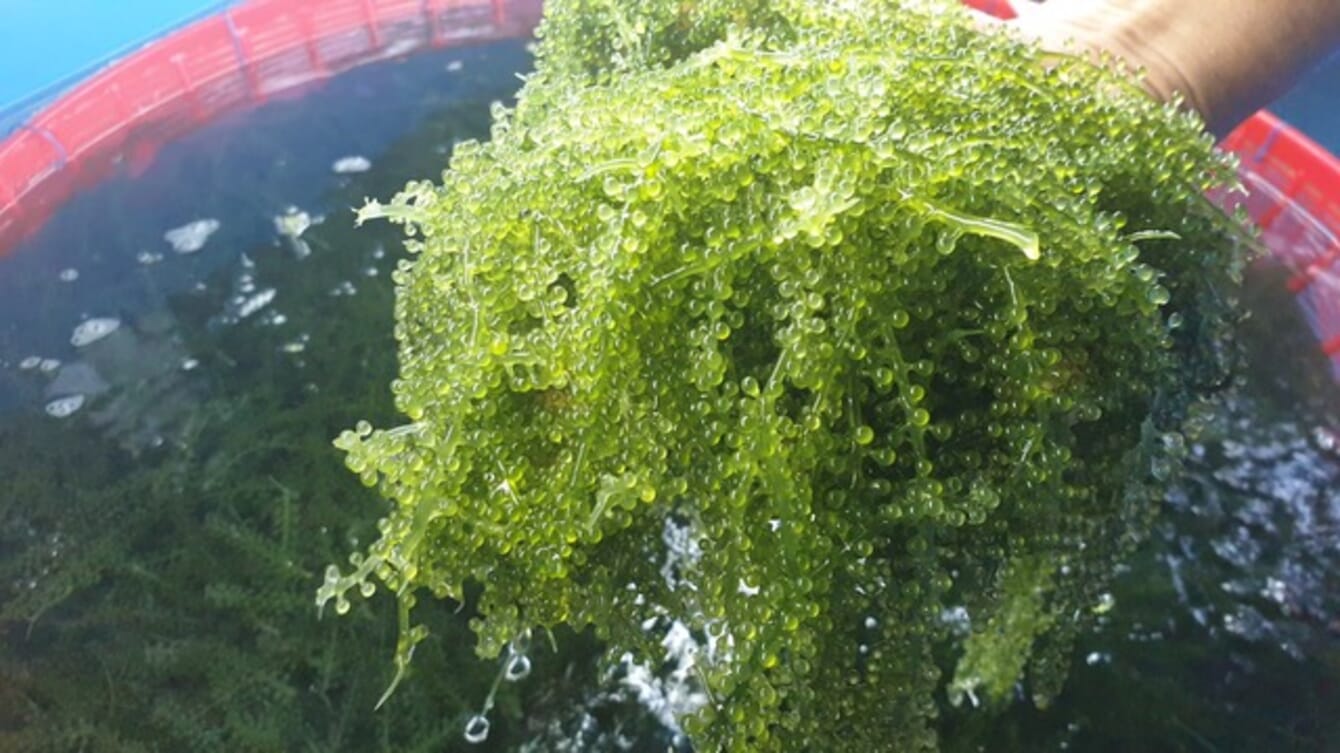
Like many forms of algae sea grapes produce antioxidants, such as vitamins C, which are essential components of the human diet and are thought to have beneficial effects in fighting diabetes and cardiovascular disease. © Blue Aqua International
Algae have a valuable nutrient profile: low in calories, but high in protein and unsaturated fatty acids, as well as many mineral salts, vitamins and trace elements. Sea grapes, which are sometimes referred to as "green caviar" due to their taste and texture, also have a high antioxidant potential.
Aquaculture of sea grapes began rather accidentally in the 1950s, when fish farmers in the Philippines discovered that these algae could grow well in fish ponds. In the meantime, the sea vegetable is also cultivated in Japan and Vietnam, among other places.
If green algae such as sea grapes are exposed to high levels of light radiation, harmful free radicals are formed in them. To protect themselves, the algae produce more antioxidants, such as vitamins C and E, β-carotene and various polyphenols, substances that make their nutritional profile particularly valuable. Such antioxidants are essential components of the human diet and are thought to have beneficial effects in humans on many ailments, including diabetes and cardiovascular disease.
Could farmers take advantage of increased light exposure to cost-effectively improve the quality of sea grapes? This was the question posed by Lara Stuthmann, a marine biologist at the ZMT and lead author of the study – the results of which have just been published in the journal Algal Research.
For her research, which was undertaken in cooperation with the marine botany group of the University of Bremen, she exposed sea grapes to five different light intensities for 14 days each. Subsequently, the antioxidant content was determined photometrically. Stuthmann compared the results with various fruits, such as pomegranate, goji berries and chokeberries, which are known for their high antioxidant content and are therefore considered "superfruits”.
She discovered that targeted irradiation can more than double the antioxidant content of sea grapes, reaching levels found in the seeds of pomegranates.
"Light irradiation as a cheap and simple means to increase the antioxidant content of algae has great potential. This application is also conceivable for other algae," said Stuthmann in a press release from ZMT. "However, depending on the level of irradiation, bleaching of marine grape may also occur." Therefore, the light irradiation and duration of treatment should be adjusted depending on the intended use of the algae - for example, in cosmetics or as food.
More than 10,000 different species of algae are known, but only eight different genera of algae are kept in more than 90 percent of algae cultures. Many are dried before consumption to extract certain molecules, such as carrageen or agar, which are used as gelling and thickening agents. Few are suitable for direct consumption.
"What makes sea grapes special compared to most other macroalgae is their growth habit and consistency, which make them a very pleasant palate experience. They are easy to reproduce and grow quickly," said Dr Karin Springer of the University of Bremen, co-author of the study. "Sea grapes could therefore find a place on German menus as a source of protein, antioxidants and other nutrients."
In Japan, Vietnam and China, sea grapes are in great demand and are eaten raw with various sauces, in salads or with sushi. In Europe, however, they are not yet recognised as food. Nevertheless, various top chefs have recognised the potential of this alga for their dishes.
Sea grapes could also be suitable for rearing in an integrated aquaculture that combines various farmed animals and plants. These form a natural cycle in which feed residues and biological waste materials are optimally utilised. In cooperation with algae farms in Vietnam, for example, the ZMT is testing co-cultivation of the sea grape with shrimps or the sea snail Babylonia aerolata, which is considered a delicacy in Vietnam.



